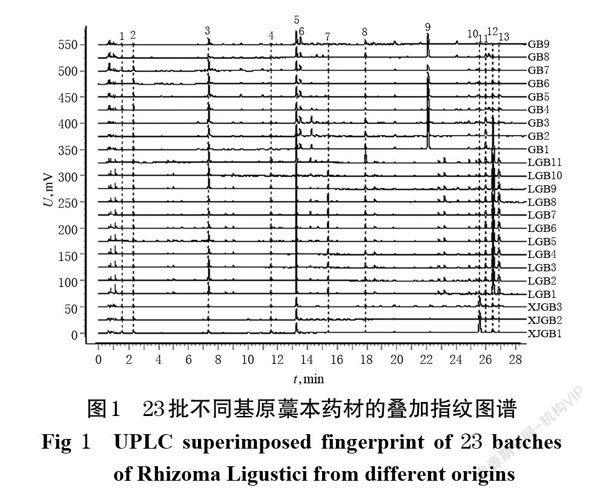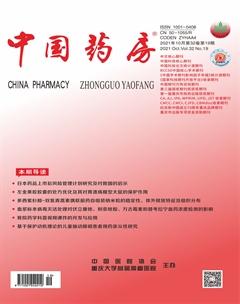不同基原藁本药材的指纹图谱建立及其化学计量学分析
梁慧 潘晓君 吕渭升 杨文惠 罗宇琴 潘礼业 霍文杰 李振雨



中圖分类号 R284.1 文献标志码 A 文章编号 1001-0408(2021)19-2358-05
DOI 10.6039/j.issn.1001-0408.2021.19.09
摘 要 目的:建立藁本、辽藁本、新疆藁本3种不同基原藁本药材的超高效液相色谱(UPLC)法指纹图谱,并进行化学计量学分析,为不同基原藁本药材的鉴别提供参考。方法:采用UPLC法检测并结合《中药色谱指纹图谱相似度评价系统(2012版)》建立23批不同基原藁本药材的指纹图谱,并进行色谱峰指认和相似度评价。采用聚类分析(CA)、主成分分析(PCA)及正交偏最小二乘判别分析(OPLS-DA)等化学计量学分析方法对不同基原藁本药材进行分析,筛选差异成分。结果:藁本、辽藁本、新疆藁本药材的UPLC指纹图谱中分别标定了13、11、11个特征峰,其中5号峰为阿魏酸;相似度评价结果显示,新疆藁本药材与辽藁本药材间的相似度为0.312~0.541,新疆藁本药材与藁本药材间的相似度为0.324~0.682,藁本药材与辽藁本药材间的相似度为0.312~0.671,表明不同基原藁本药材间的差异较大。经CA 、PCA 、OPLS-DA 发现,不同基原藁本药材各自聚为一类; 10号峰、13号峰、12号峰、7号峰、6号峰所代表的化学成分为这3种基原藁本药材的差异成分。结论:本研究建立了不同基原藁本药材的UPLC指纹图谱,筛选出了5种差异成分,可用于鉴别不同基原的藁本药材。
关键词 藁本;辽藁本;新疆藁本;基原鉴别;超高效液相色谱法;指纹图谱;聚类分析;主成分分析;正交偏最小二乘判别分析
Fingerprint Establishment of Rhizoma Ligustici from Different Origins and Their Chemometrics Analysis
LIANG Hui,PAN Xiaojun,LYU Weisheng,YANG Wenhui,LUO Yuqin,PAN Liye,HUO Wenjie,LI Zhenyu(Guangdong Yifang Pharmaceutical Co., Ltd./Guangdong Provincial Key Laboratory of Traditional Chinese Medicine Formula Granule, Guangdong Foshan 528244, China)
ABSTRACT OBJECTIVE: To establish UPLC fingerprint of Ligusticum sinense, Ligusticum jeholense and Conioselinum vaginatium, and to conduct their chemometrics analysis so as to provide reference for the identification of Rhizoma Ligustici from different origins. METHODS: UPLC method combined with Similarity Evaluation System of TCM Chromatographic Fingerprints (2012 edition) were used to establish the fingerprints of Rhizoma Ligustici from different origins. Chromatographic peak identification and similarity evaluation were carried out. Cluster analysis (CA), principal component analysis (PCA) and orthogonal partial least squares discriminant analysis (OPLS-DA) were performed to analyze Rhizoma Ligustici from different origins, and screen differential components. RESULTS: Totally 13, 11, 11 characteristic peaks were identified in UPLC fingerprints of L. sinense, L. jeholense and C. vaginatium, respectively. Similarity evaluation showed that the similarity between C. vaginatium and L. jeholense were 0.312-0.541; that between C. vaginatium and L. sinense were 0.324-0.682; that between L. sinense and L. jeholense were 0.312-0.671, indicating there was great difference among Rhizoma Ligustici from different origins. CA, PCA and OPLS-DA showed that Rhizoma Ligustici from different origins were clustered into each category respectively; chemical components represented by peak 10, peak 13, peak 12, peak 7 and peak 6 were differential components for Rhizoma Ligustici from 3 origins. CONCLUSIONS: The study establishes UPLC fingerprint of Rhizoma Ligustici from different origins, and screens 5 differential components, which can be used to identify Rhizoma Ligustici from different origins.

